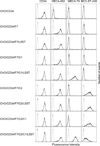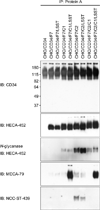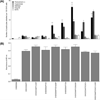Prominent expression of sialyl Lewis X-capped core 2-branched O-glycans on high endothelial venule-like vessels in gastric MALT lymphoma
- PMID: 21432854
- PMCID: PMC3076943
- DOI: 10.1002/path.2851
Prominent expression of sialyl Lewis X-capped core 2-branched O-glycans on high endothelial venule-like vessels in gastric MALT lymphoma
Abstract
High endothelial venule (HEV)-like vessels have been observed in gastric B cell lymphoma of mucosa-associated lymphoid tissue type (MALT lymphoma), as well as in its preceding lesion, chronic Helicobacter pylori gastritis. Previously we reported that glycans on HEV-like vessels in the latter lesion served as L-selectin ligands, although their function is unclear. We have investigated sialyl Lewis X (sLeX)-related glycoepitopes and found that MECA-79(-) /HECA-452(+) /NCC-ST-439(+) HEV-like vessels preferentially mark gastric MALT lymphoma compared to chronic H. pylori gastritis. We then constructed CHO cell lines expressing potential MECA-79(-) /HECA-452(+) /NCC-ST-439(+) glycans, as well as other sLeX-type glycans, on CD34 and evaluated L-selectin binding to those cells, using L-selectin-IgM chimera binding and lymphocyte adhesion assays. L-selectin-IgM chimeras bound to CHO cells expressing 6-sulpho-sLeX attached to core 2-branched O-glycans with or without 6-sulpho-sLeX attached to extended core 1 O-glycans, but only marginally to other CHO cell lines. By contrast, CHO cells expressing 6-sulpho-sLeX attached to extended core 1 and/or core 2-branched O-glycans, as well as non-sulphated sLeX attached to core 2-branched O-glycans, showed substantial lymphocyte binding, while binding was negligible on lines expressing 6-sulpho- and non-sulphated sLeX attached to N-glycans and non-sulphated sLeX attached to extended core 1 O-glycans. These results indicate that MECA-79(-) /HECA-452(+) /NCC-ST-439(+) glycans, specifically, 6-sulpho- and non-sulphated sLeXs attached to core 2-branched O-glycans, expressed on HEV-like vessels in gastric MALT lymphoma function as L-selectin ligands and likely contribute to H. pylori-specific T cell recruitment in the progression of gastric MALT lymphoma.
Copyright © 2011 Pathological Society of Great Britain and Ireland. Published by John Wiley & Sons, Ltd.
Conflict of interest statement
No conflicts of interest were declared.
Figures








Similar articles
-
Role of sulfated O-glycans expressed by high endothelial venule-like vessels in pathogenesis of chronic inflammatory gastrointestinal diseases.Biol Pharm Bull. 2009 May;32(5):774-9. doi: 10.1248/bpb.32.774. Biol Pharm Bull. 2009. PMID: 19420741 Free PMC article. Review.
-
Roles of gastric mucin-type O-glycans in the pathogenesis of Helicobacter pylori infection.Glycobiology. 2009 May;19(5):453-61. doi: 10.1093/glycob/cwp004. Epub 2009 Jan 15. Glycobiology. 2009. PMID: 19150806 Free PMC article. Review.
-
Extended core 1 and core 2 branched O-glycans differentially modulate sialyl Lewis X-type L-selectin ligand activity.J Biol Chem. 2003 Mar 14;278(11):9953-61. doi: 10.1074/jbc.M212756200. Epub 2003 Jan 15. J Biol Chem. 2003. PMID: 12529363
-
Induction of peripheral lymph node addressin in human gastric mucosa infected by Helicobacter pylori.Proc Natl Acad Sci U S A. 2004 Dec 21;101(51):17807-12. doi: 10.1073/pnas.0407503101. Epub 2004 Dec 9. Proc Natl Acad Sci U S A. 2004. PMID: 15591109 Free PMC article.
-
A potential role for 6-sulfo sialyl Lewis X in metastasis of bladder urothelial carcinoma.Urol Oncol. 2015 Nov;33(11):496.e1-9. doi: 10.1016/j.urolonc.2015.05.026. Epub 2015 Jun 29. Urol Oncol. 2015. PMID: 26137907
Cited by
-
Efficient Mapping of Sulfated Glycotopes by Negative Ion Mode nanoLC-MS/MS-Based Sulfoglycomic Analysis of Permethylated Glycans.Anal Chem. 2015 Jun 16;87(12):6380-8. doi: 10.1021/acs.analchem.5b01409. Epub 2015 Jun 5. Anal Chem. 2015. PMID: 26016788 Free PMC article.
-
Distinct substrate specificities of human GlcNAc-6-sulfotransferases revealed by mass spectrometry-based sulfoglycomic analysis.J Biol Chem. 2018 Sep 28;293(39):15163-15177. doi: 10.1074/jbc.RA118.001937. Epub 2018 Aug 9. J Biol Chem. 2018. PMID: 30093410 Free PMC article.
-
Use of novel mutant galactosyltransferase for the bioconjugation of terminal N-acetylglucosamine (GlcNAc) residues on live cell surface.Bioconjug Chem. 2013 Jan 16;24(1):144-52. doi: 10.1021/bc300542z. Epub 2013 Jan 3. Bioconjug Chem. 2013. PMID: 23259695 Free PMC article.
-
Apical membrane expression of distinct sulfated glycans represents a novel marker of cholangiolocellular carcinoma.Lab Invest. 2016 Dec;96(12):1246-1255. doi: 10.1038/labinvest.2016.104. Epub 2016 Oct 17. Lab Invest. 2016. PMID: 27748735
-
Biosynthesis and Functional Significance of Peripheral Node Addressin in Cancer-Associated TLO.Front Immunol. 2016 Aug 9;7:301. doi: 10.3389/fimmu.2016.00301. eCollection 2016. Front Immunol. 2016. PMID: 27555845 Free PMC article. Review.
References
-
- Freeman C, Berg JW, Cutler SJ. Occurrence and prognosis of extranodal lymphomas. Cancer. 1972;29:252–260. - PubMed
-
- Isaacson PG, Huller-Hermelink HK, Paris MA, et al. Extranodal marginal zone B-cell lymphoma of mucosa-associated lymphoid tissue (MALT lymphoma) In: Jaffe ES, Harris NL, Stein H, et al., editors. World Health Organization Classification of Tumors. Pathology and Genetics of Tumors of Haematopoietic and Lymphoid Tissues. Lyon: IARC Press; 2001. pp. 157–160.
-
- Wotherspoon AC, Ortiz-Hidalgo C, Falzon MR, et al. Helicobacter pylori-associated gastritis and primary B-cell gastric lymphoma. Lancet. 1991;338:1175–1176. - PubMed
-
- Hussell T, Isaacson PG, Crabtree JE, et al. Helicobacter pylori-specific tumour-infiltrating T-cells provide contact dependent help for the growth of malignant B cells in low-grade gastric lymphoma of mucosa-associated lymphoid tissue. J Pathol. 1996;178:122–127. - PubMed
-
- Hussell T, Isaacson PG, Crabtree JE, et al. The response of cells from low-grade B-cell gastric lymphomas of mucosa-associated lymphoid tissue to Helicobacter pylori. Lancet. 1993;342:571–574. - PubMed
Publication types
MeSH terms
Substances
Grants and funding
LinkOut - more resources
Full Text Sources
Other Literature Sources
Medical

